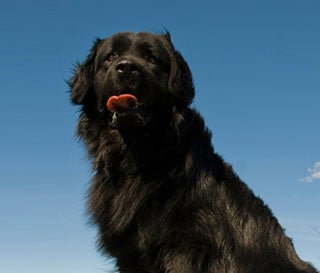Learn about dog breeds
Detailed information & photos on over 190 different breeds
Description
The Newfoundland breed is a very sturdy, large dog with a big, round head and a square muzzle. His eyes are low and he has expressive eyebrows. His ears are triangular and they fold forward on his head. He has a short neck and a squared body with a deep chest and straight front and hind legs with well defined musculature. His tail is long with a slight curl at the end, and it is carried low unless the dog is walking or running. He carries his head high and looks both intelligent and proud; his stature is such that he also appears powerful and dignified.
Coat Description
The Newfoundland has a double coat. The coat is medium length and straight or slightly wavy, but not curly. The undercoat is much like wool. Both the under and outer coat have oils to keep dirt from penetrating the coat. The tail, legs and belly often have longer hair.
The Newfoundland is commonly white, black and gray, or brown or black.
History
Newfoundlands are named for their place of origin, Newfoundland, Canada. They were bred from Labradors, Great Pyrenees, and Tibetan Mastiffs. The Newfoundland therefore has the appearance of the Great Pyrenees with the abilities and coloration of the Labrador.
He was originally used a fishing dog and was often used as a water retriever. They were also used as rescue dogs. Their heavy double coats and sturdy build made them perfect dogs to be used in and around the Atlantic Ocean. As land dogs, they were guard dogs and pack dogs. The dog was taken by settlers into all parts of North America and eventually into Europe. He is currently a common sight at obedience and water trials.
Temperament
Surprisingly, the Newfoundland is a terrific house pet even though he is a very large animal. He can adapt well to small homes and is actually careful of objects around him rather than knocking things down. The dog's temperament in general is very calm and gentle. He is patient, intelligent, and will protect his family by standing between them and a potential threat. The breed is incredibly loyal and does not do well in situations where he is removed from his family. He will even grieve the loss of another family pet or a family member. He is well adapted to other animals and will not be aggressive except sometimes around female Newfoundlands. Despite his size, he gets along well with animals of all sizes, even cats. He is easy to train and some dogs can even housebreak themselves. He is sensitive to harsh noises like raised voices, so he is best in a quiet, positive environment.
The Newfoundland is excellent with children, and can interact with children of almost any age patiently and calmly. He protects children and family members, and will play with anyone. He travels well and will participate in almost any activity with the family.
Health Problems
Because he is a large breed, The Newfoundland is prone to a lot of diseases present in large purebred dogs. He is prone to Sub-Aortic Stenosis, hip dysplasia, elbow dysplasia, gastric torsion, and several common eye problems. Von Willebrand's Disease, which is an abnormal bleeding disorder, as well as Epilepsy, a seizure disorder, are also present in the breed. Since these are serious genetic disorders, these Newfoundland dogs will not be bred by reputable breeders.
Grooming
The best way to groom a Newfoundland is with a stiff bristled brush or a pin brush. He has a thick double coat that can easily become matted if not closely looked after, so groom a Newfoundland several times a week. The breed will shed their undercoat in the spring and in the fall. Shedding is lessened in mild, regulated climates or in dogs that are mainly indoor dogs. The Newfoundland has natural oils in his fur to keep him clean, so only use dry shampoo powders. Always check his ears and eyes to be sure they are clean and healthy.
Exercise
Because Newfoundlands are generally a lazier breed, their exercise amount needs to be monitored. He needs to be encouraged to exercise by another dog or a family member. Regular exercise will help prevent some of the possible health problems he could develop, like obesity. The breed does best at short periods of play and exercise, but can tolerate long, slow jogs with a master. He loves to swim, and this is his preferred methods of exercise. If you are exercising the dog outside in the heat, watch him for signs of heat stroke and get him out of the heat as soon as possible. It is important to note that long periods of exercise, especially in the first two years of life, are not recommended as the dog does not mature until age 2 and can sustain damage to his body from extended physical exertion.
Training
Newfoundlands are very easy to train, but it should be noted that the breed responds best to positive reinforcement training methods. Loud, raised voices are discouraging to the sensitive breed, so repetition and positive rewards will help the dog learn faster. Newfoundland puppies grow very quickly and can be quite uncoordinated, so be patient as the puppy learns to control his body for commands like "sit" and "lay down".
The dog should be trained by only one person initially, and then other family members, even children, can learn to work with the dog later on. Training sessions for the Newfoundland should be shorter and occur a few times a day, rather than all at one long stretch.
Advertise | Privacy Policy | Terms of Use | Contact Us © Copyright 2004-2024 PupCity.com. All rights reserved.
